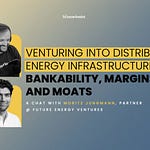Welcome to the 88th edition of Deep Tech Catalyst, the channel from The Scenarionist where science meets venture!
This episode is a little different.
Usually, we focus on what founders can do to raise capital from investors. But today, we flip the lens to look at the upstream mechanics of Deep Tech investing, tracing how institutional capital flows, who allocates it, and what it really takes to build a fundable venture portfolio.
To decode this angle, we welcome Béla Hanratty, Co-founder and Managing Partner at Keeling Capital!
Together, we explore the role of the Limited Partner in shaping the Deep Tech landscape—from fund selection and capital allocation to GP evaluation, risk modeling, and co-investment strategy.
In this edition, we break down:
How institutional capital flows into Deep Tech—from asset owners to startups
How LPs distill 500+ fund managers down to 10 high-conviction bets
What makes a GP truly differentiated—and where most fall short
How LPs assess capital intensity, deployment models, and scale-up risk
What early-stage and growth-stage strategies must get right to outperform
Whether you’re a founder raising capital, a first-time manager entering the market, or an investor looking to understand how institutional LPs think, this conversation is your inside look at the capital side of deep tech.
Let’s get into it. ⚡
✨ For more, see Membership | Deep Tech Briefing | Insights | VC Guides
BEYOND THE CONVERSATION — STRATEGIC INSIGHTS FROM THE EPISODE
The Role of Limited Partners in Deep Tech
In the private capital ecosystem, the role of the limited partner (LP) is often overlooked or misunderstood. Yet LPs are essential to how capital flows into the venture ecosystem, especially in highly technical or capital-intensive sectors like deep tech and the energy transition.
At the top of the capital chain are asset owners: pension funds, endowments, insurance groups, family offices, and wealth managers. These institutions manage large pools of capital on behalf of individuals and beneficiaries, but they often lack the internal expertise required to evaluate frontier sectors. Areas like advanced energy systems, next-gen manufacturing, or scientific hardware typically sit outside their in-house capabilities.
That’s where specialized LPs come in. These firms act as intermediaries—raising capital from institutional asset owners and deploying it into venture and growth-stage funds that focus on technical innovation. In many cases, they also build direct exposure to specific companies through co-investment strategies, allowing them to complement fund commitments with hands-on participation in breakout opportunities.
In doing so, these limited partners serve a dual purpose: they provide asset owners with credible, thesis-aligned access to complex markets, and they help accelerate the deployment of capital into startups that are shaping future infrastructure and industrial systems.
The relationship with general partners (GPs) is central. LPs select and back managers whose strategies align with the LP’s investment thesis, then work closely with them across fund cycles.
This structure—combined with a clear investment focus—is what enables capital to move efficiently from asset owners to the startups building the next wave of scientific and industrial technologies.
Case Study
Mapping the Global Manager Landscape
To understand practically how capital reaches the most investable deep tech companies, it’s interesting to look at how a specialist limited partner identifies and selects venture funds.
In Keeling’s case, the process begins by systematically mapping the global landscape of managers operating in the clean energy transition from early-stage to growth. Roughly 500 firms are identified worldwide as relevant to this mandate.
Over time, they initiate direct conversations with more than 400 of these managers, often building relationships that span multiple years and fund cycles. These discussions go beyond introductory calls—they focus on strategy evolution, sourcing advantages, and organizational maturity.
From this initial pool, only a select group makes it into the portfolio. For instance, in the LP’s first fund, 7 managers were chosen.
Importantly, selection is not based solely on manager quality in isolation. It’s also a matter of balance. Even if multiple top-performing firms are focused on the same stage or sector, they may not all be included. Portfolio construction requires diversification across stage, geography, and technology type to manage risk and optimize exposure.
The filtering process is iterative and comparative. Managers are evaluated on team composition, track record, sector alignment, and execution capability—but also on how they complement each other within a single capital pool.
From Fund Exposure to Direct Co-Investments
Once the fund portfolio is established, the LP leverages those relationships to gain access to individual companies.
Across the 500 managers originally mapped, there are an estimated 45,000 climate tech companies in aggregate portfolios. However, the LP narrows its scope to companies backed by its selected managers. That brings the pool down to roughly 500 companies monitored for co-investment potential.
From there, only 10 companies are expected to receive direct capital.
AI ≠ SaaS: the Metrics Reset.
Why Continuous Calibration/Continuous Development (CC/CD) Redefines Scalability and Risk in AI Startups.
Execution, Fit, and Differentiation
Establishing GP-Thesis Fit: The First Filter
For limited partners allocating to deep tech strategies, the first evaluation step is not track record—it's alignment between a manager’s stated strategy and their actual capabilities.
Can this team credibly execute the approach they’ve outlined?
This filter—commonly referred to as “GP-thesis fit”—often disqualifies a large share of potential candidates early in the process.
For example, if a team with prior experience in SaaS or consumer tech proposes to invest in industrial sectors like hydrogen, nuclear, or heavy manufacturing, that may create an immediate disconnect. These sectors operate on different timelines, risk profiles, and capital requirements. Without a relevant operational or investing background, it becomes difficult for LPs to confidently underwrite the team.
Establishing GP thesis fit is not about penalizing new entrants; it’s about ensuring internal consistency between sector focus and team expertise.
Identifying Differentiation: The Inflection Points That Matter
Once basic credibility is established, the next step is to determine what sets this manager apart from hundreds of other firms targeting similar areas.
To do this, the LP analyzes the venture value chain in 5 stages:
Sourcing: Access to deal flow and founder networks
Selection: Technical and commercial evaluation of investable opportunities
Entry discipline: Deal structuring and pricing
Value creation: Active support and de-risking at the company level
Exit: Timing and execution of liquidity events
Managers are not expected to excel at every stage. What matters is whether they have an unfair advantage at one or more points in that chain—something that allows them to drive consistent outperformance relative to peers.
For early-stage managers, sourcing is often the defining edge. Access to technical repeat founders, elite alumni networks, or university spinouts can provide a significant moat. In these scenarios, credibility and founder trust become central to deal access.
Selection is equally important. Technical feasibility alone is not enough—managers need to assess scalability, capital structure, and follow-on risk. A poor cap table or an unrealistic development timeline can undermine even promising technologies.
At later stages, the inflection point shifts. The deal universe is more transparent, and proprietary sourcing plays a smaller role. What differentiates successful growth-stage managers is often their ability to structure disciplined deals, win allocations in competitive rounds, and add tangible value post-investment.
Red Flags: Where the Process Ends
Throughout the diligence process, the most common reason a manager is rejected is a lack of thesis alignment. Other red flags include:
Strategies disconnected from the team's domain expertise
Shallow or generic sourcing pipelines
Inadequate understanding of capital requirements in complex sectors
Ultimately, the LP is not looking for perfection—but for proof points that signal repeatable advantage, grounded in differentiated insight and operational realism.
What Sets a Manager Apart
Once the LP is satisfied that a manager is credible and qualified—that is, they pass the “GP thesis fit” test—differentiation becomes the driving filter.
The key question is: among the hundreds of teams pursuing this opportunity set, why this one?
That question isn’t answered through branding, pitch decks, or even historical returns alone. It’s answered by identifying the inflection points in a manager’s process where they consistently outperform peers.
Whether it’s a world-class sourcing network, a unique perspective on technical diligence, or exceptional post-investment support, there has to be something structurally different—something that changes the expected outcome.
Fund Design and Capital Journey
Aligning Fund Size with Execution Strategy
One of the most overlooked aspects of evaluating a venture fund is the relationship between fund size and investment strategy. In deep tech, this alignment is especially critical.
From the LP’s perspective, a mismatch between the two is a red flag.
For instance, a $100 million fund planning to lead late-stage growth rounds is unlikely to be credible, simply because it won’t have the capacity to write competitive checks. Conversely, a billion-dollar early-stage fund may struggle to deploy capital efficiently without compromising discipline or overextending the portfolio. Furthermore, according to the guest, a fund smaller than $50 million could lack sufficient resources for team-building, portfolio support, or follow-on participation.
The goal is not to impose rigid thresholds, but to ensure that fund size is commensurate with stage, sector, and intended role in the capital stack. Alignment here is foundational to both risk management and performance potential.
Risk-Return Profiles: Early vs. Growth Stage
Expected returns vary depending on the stage. Early-stage funds typically aim for 3–5x+ returns, recognizing that only a subset of companies will drive the majority of outcomes. These funds tend to hold larger portfolios compared to growth-stage funds (25–30 companies or more) and are subject to a stronger power-law dynamic.
In contrast, growth-stage funds may target lower multiples but benefit from more concentrated outcomes and greater downside protection. The visibility of later-stage companies, combined with existing commercial traction, reduces binary risk—though not necessarily complexity.
While fund duration is generally similar across stages, the composition and structure of returns look different. LPs must calibrate expectations accordingly and build portfolios that reflect both return ambition and capital efficiency.
Evaluating the Capital Intensity of Deep Tech Companies
In Deep Tech, capital intensity is not inherently negative—but it must be understood and managed with precision.
Some technologies require large amounts of funding to scale, particularly those tied to physical infrastructure or advanced hardware.
What matters is not how much capital is needed, but how it’s sequenced.
If a company remains reliant on equity financing too far into its lifecycle, the dilution risk increases dramatically—for founders and early investors alike.
For example, if a commercial facility requires $100 million or more and no non-dilutive capital is available, the company may become structurally uninvestable.
LPs watch for signs that the financing strategy includes a credible path toward blended capital: project finance, asset-backed lending, or strategic partnerships that reduce reliance on dilutive equity.
Understanding this trajectory is essential—not just for individual companies, but for the managers backing them. Fund strategy must include realistic assumptions about capital scale, timing, and the viability of future rounds.
For LPs focused on long-term value creation, this distinction matters. Technologies that remain confined to research labs or demo units may be theoretically impressive, but without real-world performance data, customer engagement, and operational feedback, they struggle to attract later-stage capital or non-dilutive financing.
Meanwhile, incumbents continue to iterate and improve.
The preferred model is deployment-led innovation: getting early versions into the field, gathering real usage data, and adapting with customer input.
This approach builds technical maturity and unlocks access to more diverse funding sources over time.
Can the company escape equity dependence?
One of the most overlooked risks in deep tech is over-dilution. As capital requirements mount, founders and early backers may face recapitalizations or exit the cap table entirely.
LPs look for companies that can build their first commercial unit with $10 million instead of $100 million, or deploy a small fleet of systems that can later be refinanced through debt, asset-backed lending, or project finance.
If the underlying unit economics are sound—and the early deployments de-risked—the company can graduate to more efficient forms of capital.
Ultimately, in deep tech, scale is not achieved in theory. It is achieved in the field, through systems that work, customers who pay, and financing structures that evolve with the technology.













